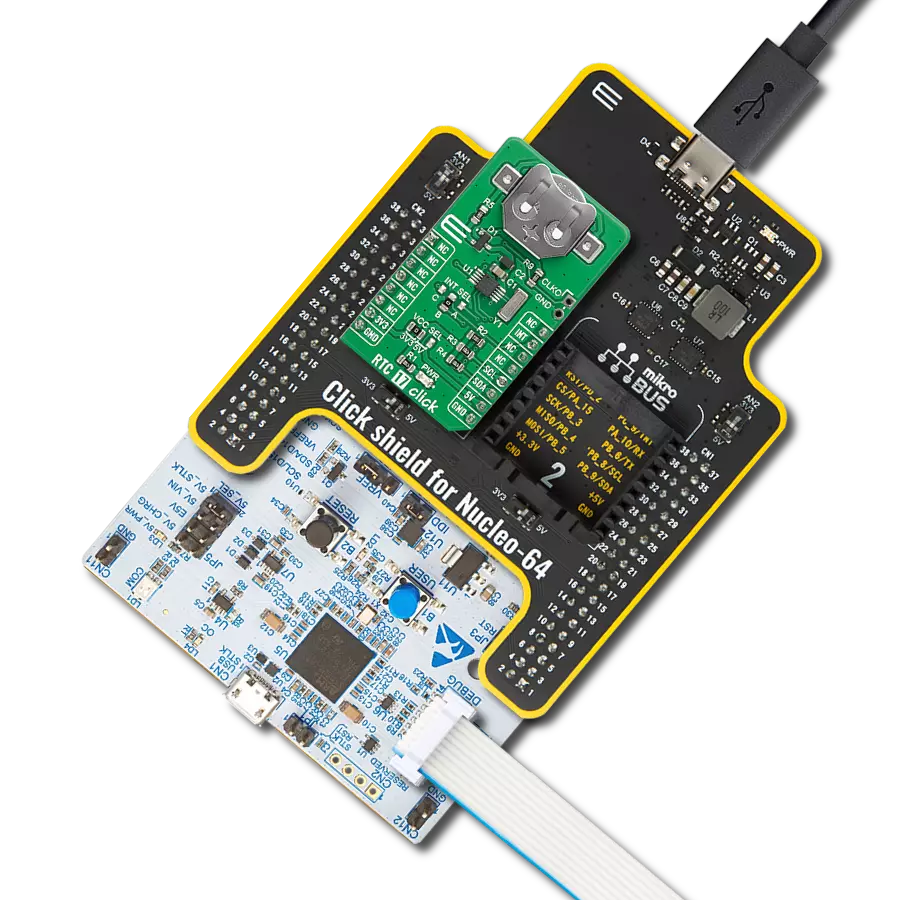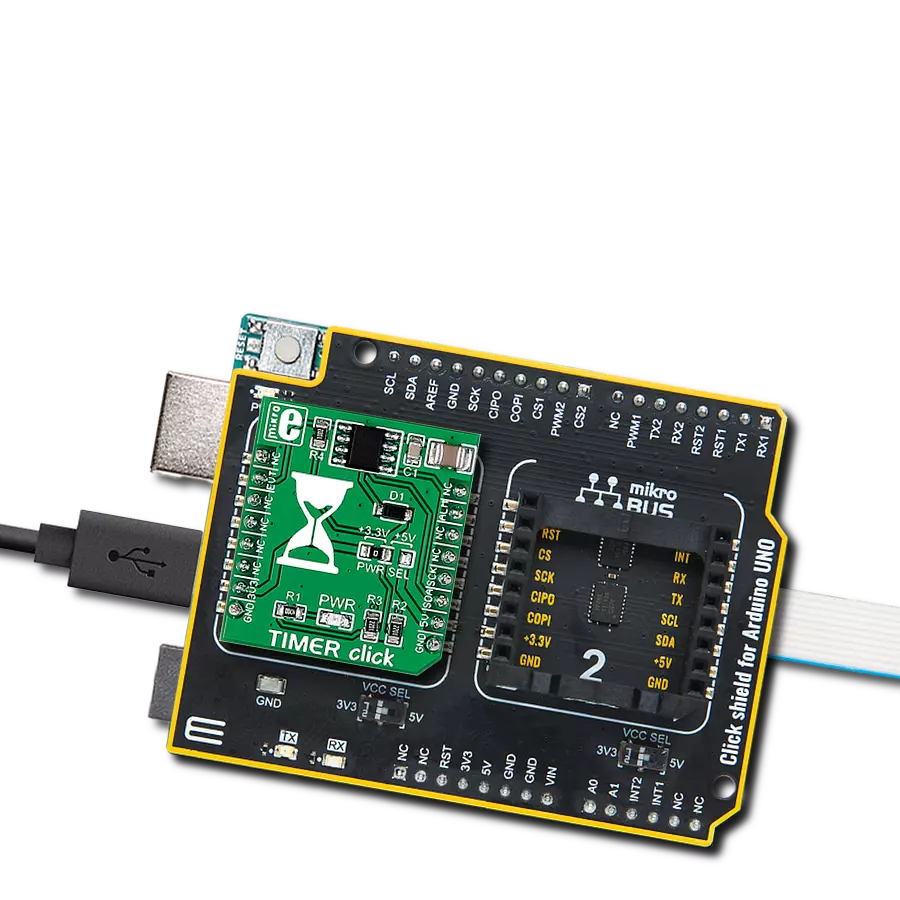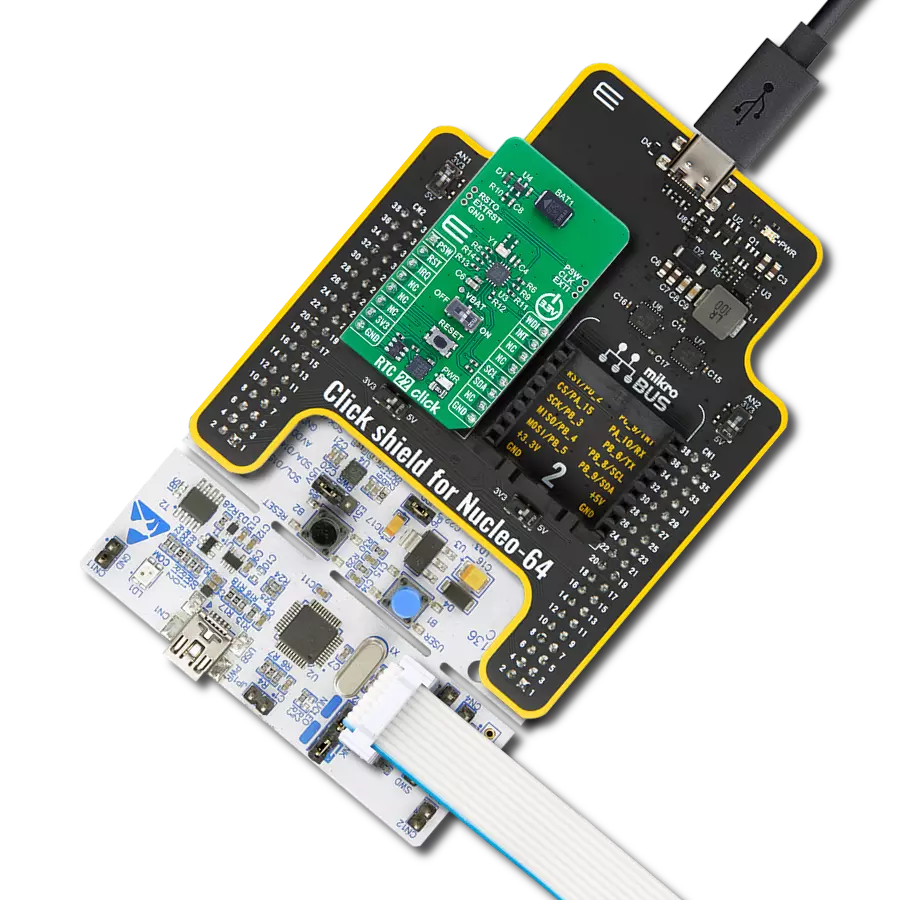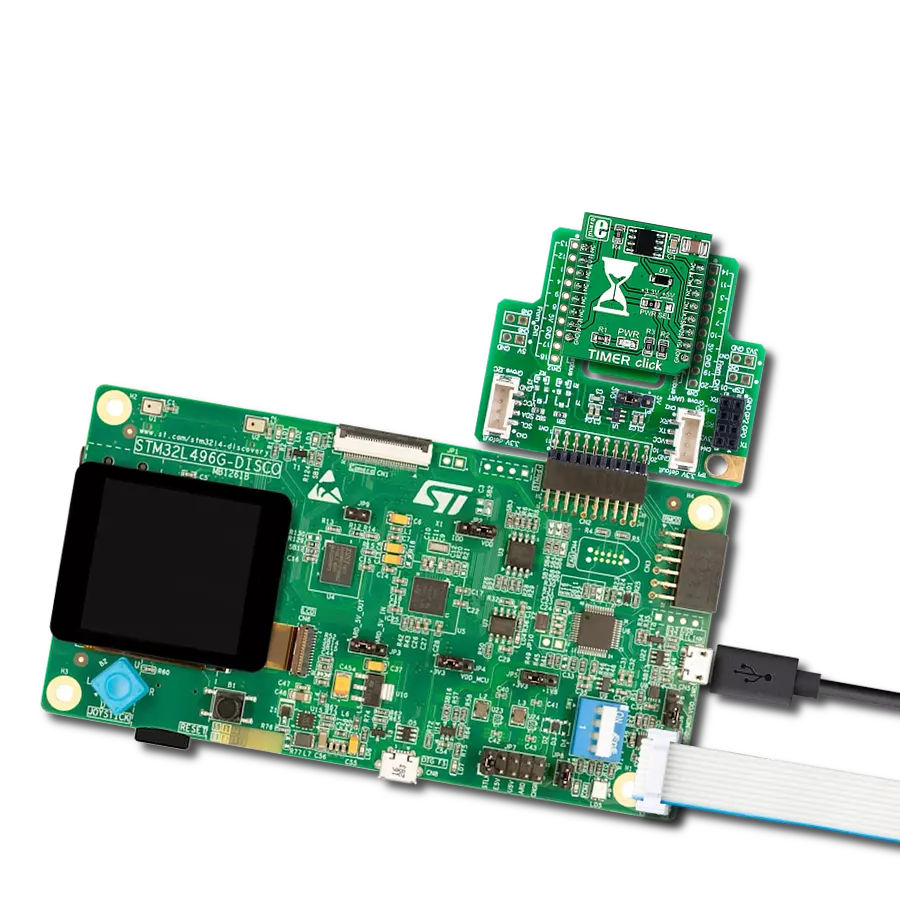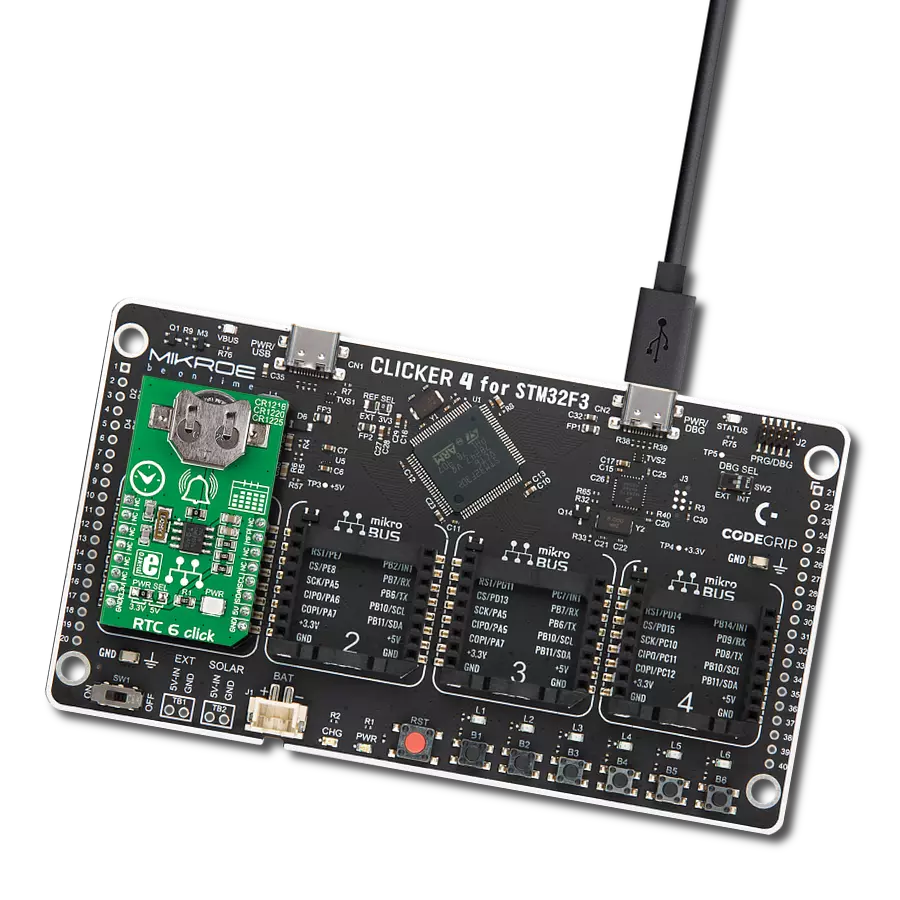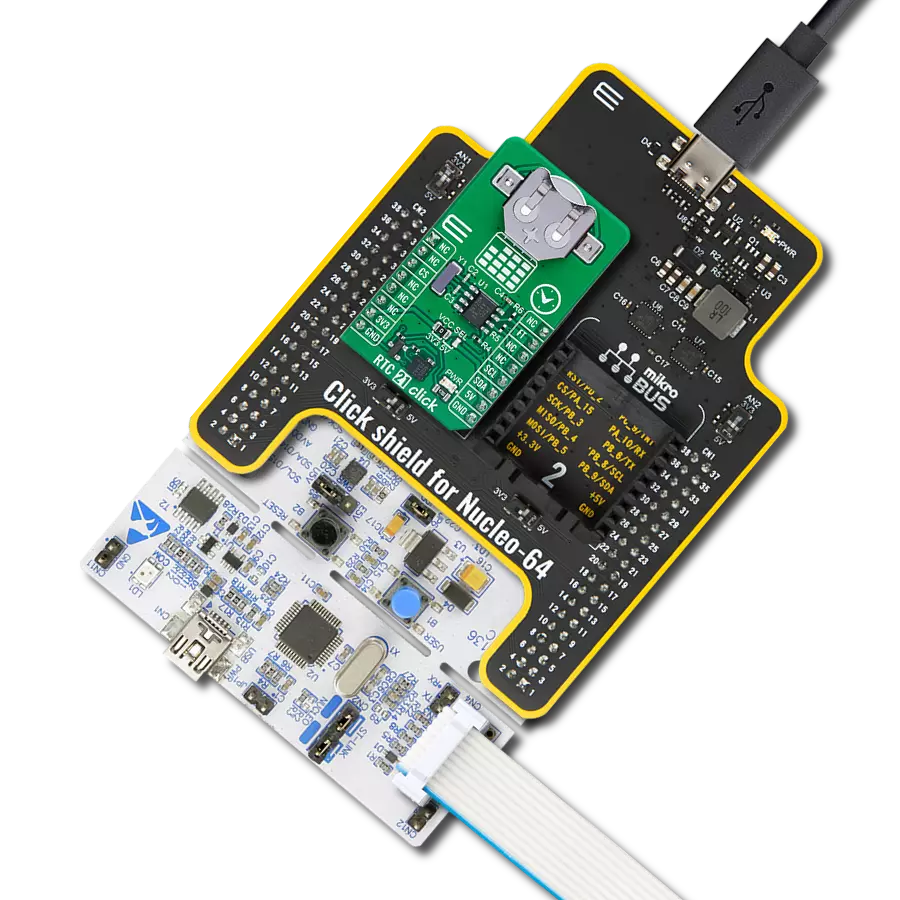Achieve seamless coordination and synchronization of events in your applications with our cutting-edge real-time clock solution
A
A
Hardware Overview
How does it work?
RTC 8 Click is based on the RV-3028-C7, an extreme low power real-time clock/calendar (RTC) module from Micro Crystal Switzerland. Thanks to its high integration level, this module provides high time accuracy, factory calibrated to 1 ppm, with a very low count of external components required. It has a full RTC function, offering programmable counters, alarms, and an interrupt engine with selectable event reporting sources. In addition to a standard clock output function, it also offers a 32-bit UNIX Time counter. The operational parameters are stored within the internal non-volatile memory (EEPROM) allowing their persistence in the event of the complete power failure. The small dimension of the RV-3028-C7 module itself, allow it to be used in very space-constrained applications, including wearables, medical equipment, and similar. In addition to the RV-3028-C7, RTC 8 click is equipped with the button cell battery holder compatible with the CR1225 battery. By utilizing an automatic backup switch, the IC is able to use an external battery power source when there is no power supply on its main power terminals, thus
allowing for uninterrupted operation. Draining as low as 40nA of current, it can be operated with the standard button cell battery almost indefinitely. In addition, a trickle charge system will replenish the battery power while the RV-3028-C7 is powered over the main power terminals (VDD, VSS). The voltage of the main power supply can range between 1.2V up to 5.5V. The RV-3028-C7 uses the I2C communication protocol for the communication with the host MCU. Besides the I2C bus lines, two additional pins are also available on the RV-3028-C7, allowing an interrupt to be reported to the host MCU, but also to capture an external event and marking it with an automatic timestamp. The user is able to set up standard clock and calendar functions (including seconds, minutes, hours, weekdays, date, months, years with leap year correction), as well as the interrupt functions for the periodic countdown timer, periodic time update, alarm, external event, automatic backup switchover and power on reset (POR) events. All these features are available when the module is operated over the backup power supply (battery). A group of configuration registers
is used to set up all the various working parameters of the device. To additionally prevent any unintentional changes of the internal registers, the RV-3028-C7 offers password protection of its configuration. If the password protection is set by an enable register in the non-volatile memory, each time the register configuration is attempted, the user will be required to enter the password first. Naturally, reading out the password registers will return 0 values; this register is write-only. Besides other functions, EEPROM memory holds the offset correction values. Offset correction is required for fine-tuning the internal 32.768 kHz XTAL, as well as for compensating the aging phenomenon. This Click board™ can operate with either 3.3V or 5V logic voltage levels selected via the VCC SEL jumper. This way, both 3.3V and 5V capable MCUs can use the communication lines properly. Also, this Click board™ comes equipped with a library containing easy-to-use functions and an example code that can be used as a reference for further development.
Features overview
Development board
Fusion for PIC32 v8 is a development board specially designed for the needs of rapid development of embedded applications. It supports a wide range of Microchip's PIC32 microcontrollers regardless of their number of pins and a broad set of unique functions, such as the first-ever embedded debugger/programmer over WiFi. The development board is well organized and designed so that the end-user has all the necessary elements, such as switches, buttons, indicators, connectors, and others, in one place. Thanks to innovative manufacturing technology, Fusion for PIC32 v8 provides a fluid and immersive working experience, allowing access anywhere and under any circumstances at any time. Each part of the
Fusion for PIC32 v8 development board contains the components necessary for the most efficient operation of the same board. In addition to the advanced integrated CODEGRIP programmer/debugger module, which offers many valuable programming/debugging options and seamless integration with the Mikroe software environment, the board also includes a clean and regulated power supply module for the development board. It can use a wide range of external power sources, including a battery, an external 12V power supply, and a power source via the USB Type-C (USB-C) connector. Communication options such as USB-UART, USB HOST/DEVICE, CAN (on the MCU card, if
supported), and Ethernet is also included. In addition, it also has the well-established mikroBUS™ standard, a standardized socket for the MCU card (SiBRAIN standard), and two display options for the TFT board line of products and character-based LCD. Fusion for PIC32 v8 is an integral part of the Mikroe ecosystem for rapid development. Natively supported by Mikroe software tools, it covers many aspects of prototyping and development thanks to a considerable number of different Click boards™ (over a thousand boards), the number of which is growing every day.
Microcontroller Overview
MCU Card / MCU
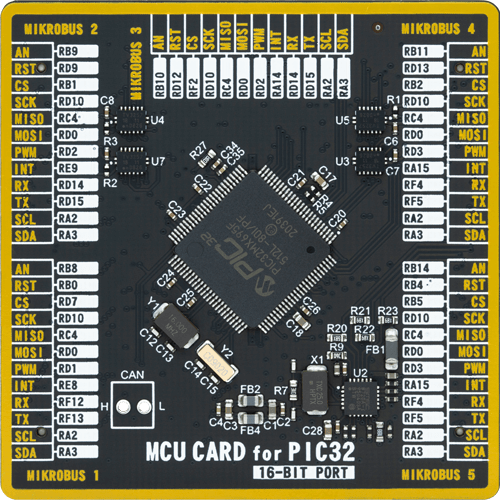
Type
8th Generation
Architecture
PIC32
MCU Memory (KB)
512
Silicon Vendor
Microchip
Pin count
100
RAM (Bytes)
131072
Used MCU Pins
mikroBUS™ mapper
Take a closer look
Click board™ Schematic

Step by step
Project assembly
Track your results in real time
Application Output
1. Application Output - In Debug mode, the 'Application Output' window enables real-time data monitoring, offering direct insight into execution results. Ensure proper data display by configuring the environment correctly using the provided tutorial.

2. UART Terminal - Use the UART Terminal to monitor data transmission via a USB to UART converter, allowing direct communication between the Click board™ and your development system. Configure the baud rate and other serial settings according to your project's requirements to ensure proper functionality. For step-by-step setup instructions, refer to the provided tutorial.

3. Plot Output - The Plot feature offers a powerful way to visualize real-time sensor data, enabling trend analysis, debugging, and comparison of multiple data points. To set it up correctly, follow the provided tutorial, which includes a step-by-step example of using the Plot feature to display Click board™ readings. To use the Plot feature in your code, use the function: plot(*insert_graph_name*, variable_name);. This is a general format, and it is up to the user to replace 'insert_graph_name' with the actual graph name and 'variable_name' with the parameter to be displayed.

Software Support
Library Description
This library contains API for RTC 8 Click driver.
Key functions:
rtc8_set_time- Set new time - 24 hour formatrtc8_set_date- Set new datertc8_get_time_and_date- Get RTC data ( Time and Data )
Open Source
Code example
The complete application code and a ready-to-use project are available through the NECTO Studio Package Manager for direct installation in the NECTO Studio. The application code can also be found on the MIKROE GitHub account.
/*!
* \file
* \brief Rtc8 Click example
*
* # Description
* Demo application shows the operation of RTC 8 Clicks.
*
* The demo application is composed of two sections :
*
* ## Application Init
* Configuring Clicks and log objects.
* Settings the Click in the default configuration.
* Sets new: Time, Date, UNIX time and alarm data.
*
* ## Application Task
* Read current Time, Date and UNIX time and checks if the alarm is active.
*
* @note
* Comment out the lines for setting date and time if you would like the
* module to keep counting time after a reset or shut down.
*
* \author MikroE Team
*
*/
// ------------------------------------------------------------------- INCLUDES
#include "board.h"
#include "log.h"
#include "rtc8.h"
// ------------------------------------------------------------------ VARIABLES
static rtc8_t rtc8;
static log_t logger;
static rtc8_time_t time_s;
static rtc8_date_t date_s;
static rtc8_alarm_t alarm_s;
// ------------------------------------------------------- ADDITIONAL FUNCTIONS
void display_weekday ( uint8_t weekday )
{
switch ( weekday )
{
case 0:
{
log_printf( &logger, " Monday \r\n" );
break;
}
case 1:
{
log_printf( &logger, " Tuesday \r\n" );
break;
}
case 2:
{
log_printf( &logger, " Wednesday \r\n" );
break;
}
case 3:
{
log_printf( &logger, " Thursday \r\n" );
break;
}
case 4:
{
log_printf( &logger, " Friday \r\n" );
break;
}
case 5:
{
log_printf( &logger, " Saturday \r\n" );
break;
}
case 6:
{
log_printf( &logger, " Sunday \r\n" );
break;
}
}
}
// ------------------------------------------------------ APPLICATION FUNCTIONS
void application_init ( void )
{
log_cfg_t log_cfg;
rtc8_cfg_t rtc8_cfg;
/**
* Logger initialization.
* Default baud rate: 115200
* Default log level: LOG_LEVEL_DEBUG
* @note If USB_UART_RX and USB_UART_TX
* are defined as HAL_PIN_NC, you will
* need to define them manually for log to work.
* See @b LOG_MAP_USB_UART macro definition for detailed explanation.
*/
LOG_MAP_USB_UART( log_cfg );
log_init( &logger, &log_cfg );
log_info( &logger, " Application Init " );
// Click initialization.
rtc8_cfg_setup( &rtc8_cfg );
RTC8_MAP_MIKROBUS( rtc8_cfg, MIKROBUS_1 );
if ( I2C_MASTER_ERROR == rtc8_init( &rtc8, &rtc8_cfg ) )
{
log_error( &logger, " Communication init." );
for ( ; ; );
}
if ( RTC8_ERROR == rtc8_default_cfg ( &rtc8 ) )
{
log_error( &logger, " Default configuration." );
for ( ; ; );
}
// 24h format - HH,MM,SS
time_s.hours = 23;
time_s.minutes = 59;
time_s.seconds = 50;
rtc8_set_time( &rtc8, &time_s );
// Set date format
date_s.weekdays = 5;
date_s.day = 31;
date_s.month = 12;
date_s.year = 22;
rtc8_set_date( &rtc8, &date_s );
// Set UNIX time
rtc8_set_unix_time( &rtc8, 1672527590ul );
// Set alarm format
alarm_s.weekdays = 6;
alarm_s.hours = 0;
alarm_s.minutes = 0;
rtc8_set_alarm( &rtc8, &alarm_s );
log_info( &logger, " Application Task " );
}
void application_task ( void )
{
static uint8_t time_seconds = 0xFF;
uint8_t alarm = 0;
uint32_t unix_time = 0;
err_t error_flag = rtx8_get_time_and_date( &rtc8, &time_s, &date_s );
error_flag |= rtc8_get_uinx_time( &rtc8, &unix_time );
error_flag |= rtc8_get_alarm_flag( &rtc8, &alarm );
if ( ( RTC8_OK == error_flag ) && ( time_seconds != time_s.seconds ) )
{
display_weekday ( date_s.weekdays );
log_printf( &logger, " Time: %.2u:%.2u:%.2u\r\n Date: %.2u.%.2u.20%.2u.\r\n",
( uint16_t ) time_s.hours, ( uint16_t ) time_s.minutes,
( uint16_t ) time_s.seconds, ( uint16_t ) date_s.day,
( uint16_t ) date_s.month, ( uint16_t ) date_s.year );
log_printf( &logger, " UNIX: %lu\r\n", unix_time );
if ( RTC8_ALARM_IS_ACTIVE == alarm )
{
log_info( &logger, " Alarm Activated!!! " );
rtc8_reset_alarm_flag( &rtc8 );
}
log_printf( &logger, "------------------\r\n" );
time_seconds = time_s.seconds;
}
Delay_ms ( 200 );
}
int main ( void )
{
/* Do not remove this line or clock might not be set correctly. */
#ifdef PREINIT_SUPPORTED
preinit();
#endif
application_init( );
for ( ; ; )
{
application_task( );
}
return 0;
}
// ------------------------------------------------------------------------ END


















